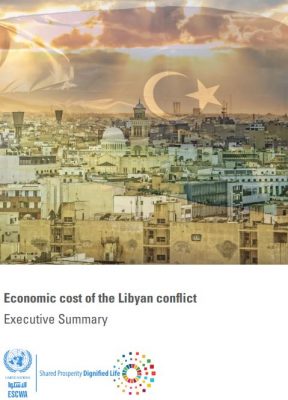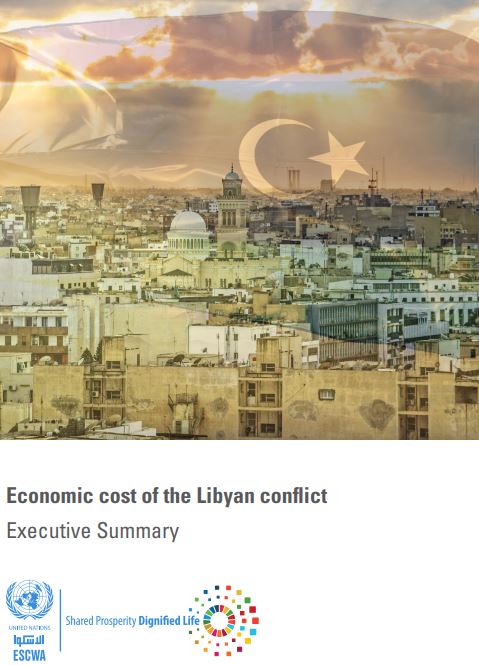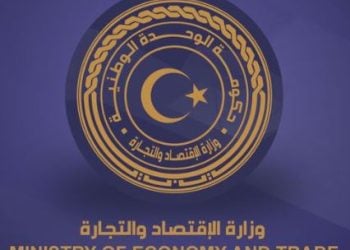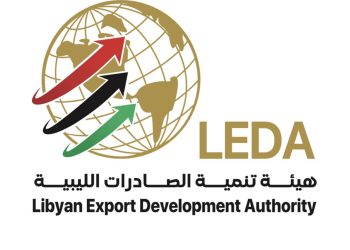By Sami Zaptia.

London, 30 September 2021:
The total cost of Libya’s conflict from its outbreak in 2011 to the present day is estimated at LD 783.4 billion (equivalent to USD 174 billion) according to a report published on 13 September by the United Nations Economic and Social Commission for Western Asia (ESCWA) entitled the “Economic Cost of the Libyan Conflict”.
The report considers the situation in Libya, where warring factions quickly engaged in a destructive conflict following the 2011 uprisings. This conflict, the report concluded, has deeply affected the Libyan economy and the economies of neighbouring countries, including Egypt, the Sudan and Tunisia, with which Libya has extensive economic relations in terms of trade, investment, and migrant workers. Regional cooperation has therefore been significantly affected by the Libyan conflict.
The Economic and Social Commission for Western Asia (ESCWA) has launched a project to examine the effects of peace and reconstruction in Libya on neighbouring countries and on regional cooperation. This project consists of two complementary phases. The first measures the direct effects of the war economy on Libya. The second estimates the opportunities generated by the peace process and reconstruction in Libya for neighbouring countries and for regional cooperation. The present report focuses on the first phase of the project.
Dutch disease
The present report asserts that high dependence on hydrocarbons in Libya underpinned the difficulties caused by rent economies (Dutch disease), which contributed to the destabilization of the former political regime and its fall in 2011.
The Dutch disease was at the core of Libya’s main economic woes before the uprisings, which include: heavy dependence on the economic dynamics of the hydrocarbon sector and its high volatility; low diversification and rigidity of economic structures; and resistance to reform and change. These ills weakened the Libyan economic system and contributed to the destabilization and downfall of the political system. The Libyan economy has seen several attempts at reform, but they have all ended in failure because of a rentier regime characterized by weak institutions and the lack of accountability of political authorities.
Consequently, dependence on export revenues, especially volatile hydrocarbon prices; low economic diversification; weak institutions; and resistance to change are all elements that have led to political instability in Libya, starting with the 2011 uprisings.
Macroeconomic effect
The conflict in Libya has shrunk the economy, particularly GDP, resulting in a decline in investment and consumption. A comparison between IMF forecasts and the performance of the Libyan economy shows that the loss of GDP, as a result of conflict, is estimated at 292.2 billion Libyan dinars between 2011 and 2015 (equivalent to USD 65 billion using the official exchange rate of the Libyan dinar/US dollar).
Compared with previous attempts to cost the economic impact of the Libyan conflict, the present assessment is more practical for the following reasons: it is the first attempt to estimate the impact of the conflict using recent data, integrating observed economic changes caused by the crisis; a tailored national model is used in the analysis, unlike in previous studies that measured long-term effects without taking into account the various channels of transmission of the conflict into the economy. Furthermore, statistical data were gathered with a prespective for new features in modelling the Libyan economy in terms of trade, consumption, production and investment.
When comparing the model projections to those made by IMF in 2009, the cost of the war in Libya from 2016 to 2020 could reach 491.2 billion Libyan dinars (equivalent to USD 109 billion using the official exchange rate of the Libyan dinar/US dollar). We estimate the total cost of the conflict from its outbreak in 2011 to the present day at 783.4 billion Libyan dinars (equivalent to USD 174 billion using the official exchange rate of the Libyan dinar/ US dollar).
Cost of conflict to rise by 2025
In the absence of a peace agreement in the coming years, the cost of the conflict will rise sharply. According to our estimates, the cost of the conflict between 2021 and 2025 will be 628.2 billion Libyan dinars (equivalent to USD 139 billion using the official exchange rate of the Libyan dinar/ US dollar), taking the total cost of the conflict to 1411.6 billion Libyan dinars over the period 2011-2025 (equivalent to USD 313 billion using the official exchange rate of the Libyan dinar/US dollar).
Three major factors have increased economic losses in Libya: the destruction of capital, the loss of productivity, and the decline in oil prices on the financial markets. Our estimates show that the vast majority of losses are related to destruction caused by the conflict.
The conflict in Libya has greatly disrupted foreign trade and paralyzed the economy. There has been a sudden and significant reduction of exports in some key products, mainly those related to the oil production sector. However, the impact of the conflict has been much higher on imports, mainly owing to a contraction in the construction and building sectors, and declining expenditures of both expatriate workers and nationals. The massive return of foreign workers to their home countries and the declining incomes of Libyan citizens are major contributors to the drop in final consumption. In addition, the unprecedented decline in public investment has intensified domestic demand for imported products.
Fiscal effect
Like other Arab oil-exporting countries, the structure of government revenues and expenditures in Libya reflects its heavy dependence on oil revenues. In Libya, oil revenues comprise the financial surplus from exports of crude and refined products; domestic refining and distribution; and revenues from foreign oil companies operating in Libya, which pay income taxes and royalties to the Government. Prior to the crisis, oil revenues contributed about two thirds of total government revenues over 2000-2010. The conflict has therefore significantly affected government revenues and spending because of the decline in economic activity, and in the State’s capacity to extract and refine oil.
Conclusions and policy response
The conflict has plunged the Libyan economy into an unprecedented crisis. Intense political negotiations are needed to restore peace and help rebuild the Libyan economy. The peace process requires a reconstruction and recovery plan based on the following three major areas:
- Ensuring effective and transparent economic governance through a competent new institutional framework to implement strategies for economic rehabilitation and recovery;
- Undertaking rehabilitation and reconstruction efforts in sectors affected by the conflict to put the Libyan economy on the path of growth;
- Boosting growth and investment through emergency short-term reconstruction programmes and medium and long-term institutional reform.
Cost of conflict in Libya exceeds US$ 576 billion: ESCWA report | (libyaherald.com)








